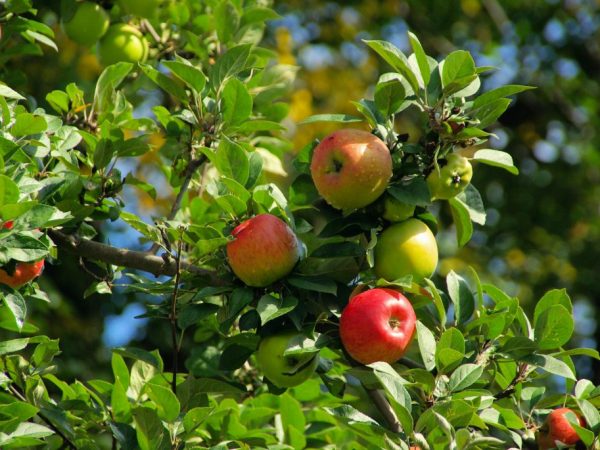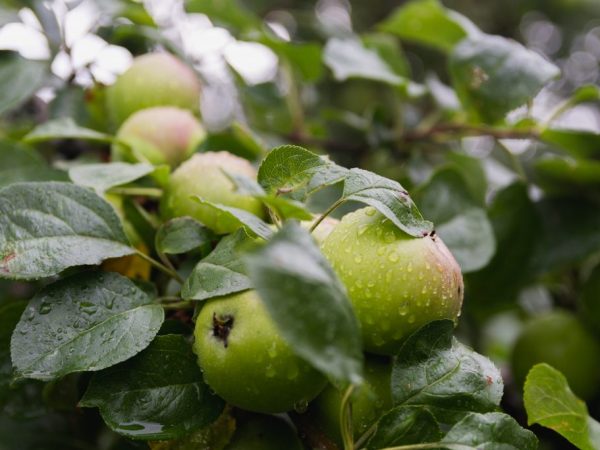Apple variety Good news
A young but very promising variety - the Good News apple tree - will be an excellent choice for a gardener. (Sometimes it is confused with another variety - Blagovest, but this is erroneous). Yablonka Good news has its advantages, disadvantages and cultivation features. Like any other variety, it must be carefully studied before purchasing.

Apple variety Good news
Description
This variety is medium in size - up to 2.5 m when grown on a seedling stock. A semi-dwarf stock allows you to get compact apple trees up to 1.5 m high.
The description of both subspecies is very similar - they have a spherical crown, bright green leaves and rounded red-sided fruits. Sometimes the apples are slightly oblong. Their weight is from 80 g to 160 g, but sometimes they grow even more.
In semi-dwarf trees, apples are usually smaller, but they are redder. The pulp is creamy, juicy, crunchy, with a sweet and sour taste. Fruiting is regular, starting from 4-5 years.
The first harvests do not exceed 20-25 kg, but by 7-10 years the tree can produce 50-60 kg per season.
Pollination
The cultivar Good News belongs to the self-fertile species: the apple tree may well do without pollinators.
But it was noticed that due to additional pollination, apples become larger. Varieties with the same flowering time, giving large sweet and sour fruits, are suitable.
Cold and pest resistance
This variety is distinguished by good winter hardiness: frosts down to -30 ° С are not afraid of it, as well as temporary cold snaps down to -35 ° С. However, in regions with harsh winters, insulation measures are required.
The tree is highly resistant to diseases and pests (especially to all types of scab), but it can be exposed to the invasion of small insects.
Advantages and disadvantages
Like all fruit trees, the apple tree has its pros and cons in the description, observation of the Good News variety has been conducted not so long ago, but important conclusions have already been drawn.
It should be borne in mind that good care of a fruit tree can compensate for many negative characteristics.
pros
- Apples are very tasty, look aesthetically pleasing and are suitable for various types of culinary processing;
- Good keeping quality of fruits (their taste does not change during storage);
- Self-fertility;
- Cold resistance;
- Stable yields;
- High scab resistance;
- Strong branches keep fruits from falling off;
- The presence of a compact subspecies on a dwarf rootstock.
Minuses

The tree must be protected from the cold
- In the conditions of harsh winters, the tree still requires insulation;
- The fruits are not very large, and in unfavorable conditions they can still become smaller;
- Weak aroma;
- The yield is not very high, rather average.
Landing
Seedlings of this type can be planted in spring or autumn.
- April is suitable for spring planting - it is especially relevant for regions with severe winters.
- In temperate climates, it can be planted in the fall, in terms of time - a month before the onset of frost.
The site must have loamy or sandy loam soil.If there is none, sand and peat are mixed into a pre-dug hole, fertilized with compost.
It is better to plant medium-sized seedling trees at a distance of 4 m from the nearest neighbors. You can leave about 3 m between the semi-dwarfs.
The apple tree should be planted in a well-lit place, at least 2 m above the groundwater. The place should not be low-lying, so that rain and melt water does not accumulate on it.
The seedling is placed in a fertilized hole, covered with earth, gently watered, and then mulched.
Agrotechnics
At first, the apple tree is watered regularly, 3-4 times a month, and if the weather is dry, twice a week.
In mid-April, root feeding is carried out with nitrogen fertilizers, during flowering - with potash and phosphorus fertilizers. In summer, potash and phosphorus mixtures alternate with nitrogen ones. In autumn, it is good to add compost and rotted manure.
An annual sanitary pruning of the tree is required, while removing damaged shoots and dried twigs.
A prerequisite for good care is the cleanliness of the trunk circle.
It is regularly weeded and mulched. In early spring, the trunk circle and bark are sprayed from pests that have overwintered there. Also, control measures are carried out before and after flowering, and spraying from the moth - 20 days before the fruit ripens.
Ripening and harvesting

Fruits can be kept fresh for five months
In the 4th year of the tree's life, you can taste several apples, but real fruiting begins in the 5th year.
Fruits ripen from mid-September to early October (with a warm sunny summer, ripeness occurs earlier). The ripe ones are well kept on the branches, so there are no problems with harvesting.
The shelf life of fruits at a temperature of 0-1 ° C is 5 months.
Growing in regions
In the Urals and in similar climatic regions, the variety grows well and bears fruit.
Due to its frost resistance, it can be grown from the Siberian region, but at the same time it can be insulated before the onset of winter.
The apple tree is easily grown in temperate and warm zones, often producing sweeter and larger fruits.
Gardeners' opinions
Apple tree Good news has a number of valuable advantages with relatively small disadvantages.
Positive reviews about her are focused on the excellent taste of the fruit - fresh and with any culinary processing.
Apples lie for a long time without losing their taste. Negative reviews indicate that the fruits can be very shallow due to unfavorable weather conditions.
The tree does not get sick with scab, and does not freeze in winter. Caring for it is not burdensome, especially for small species on a dwarf rootstock. In addition, a one and a half meter apple tree is compactly located in the smallest areas and can do without pollinating neighbors.


